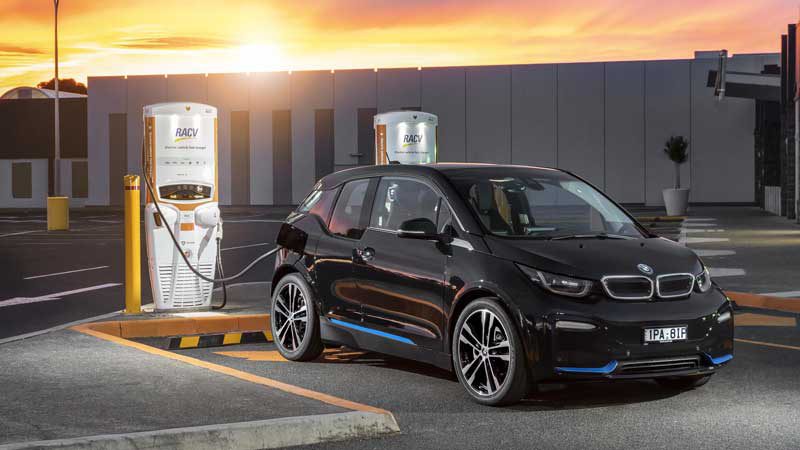There is a lot that is surprising about BMW’s latest electric vehicle offering, the new generation i3 and the 13s – upgrades of the i3 electric vehicle model that the German car manufacturer first rolled out in 2013.
The first surprise is the visual one – how it looks and how it stands out in a crowd, particularly a crowd of BMW cars/
At BMW Brisbane, where I am picking up a media loan car, I walk through an ocean of modern Minis and a few of their standard Beamers, and there, looking completely different, nearly toy-like, are a couple of original i3 EVs in for a service, and a new model ready to be picked up.
The second surprise is that this is BMW’s only EV offering to date. The German company was relatively quick out of the blocks in electric vehicles and released the first version of the i3 in 2013.
But until this updated model – with greater range and a few other additions – that is all it has done, to the frustration analysts and some former executives. Yes, BMW is now on the march to an electric future, but their other EV models won’t be seen for another couple of years, at least in Australia.
To understand the thinking behind the I3 and its success it’s probably helpful to understand something about the way that BMW viewed the world.
As the company has admitted, the i3 was designed to test the consumer appetite for electric cars without compromising its existing fleet of petrol and diesel cars. This is the clue behind its unique and idiosyncratic design, and why it doesn’t have the same muscular image that typifies its other models.
It was an interesting take, made at the time when it was thought that EVs had to look different from their petrol and diesel rivals, a theory that lasted as long as it took Tesla to underline the importance of them performing differently.
The i3 first went on sale in late 2013, featuring lightweight carbon-fibre technologies that allowed for a lighter frame and a roomier interior, and it is still being assembled at BMW’s Leipzig plant, which operates its own wind turbines to power production.
The former CEO of BMW wanted to think of the switch to EVs as an evolution. The new CEO is convinced that they are the future. But not in this form. The I3 and the i3s will not be renewed, reports in Europe say, this is the last offering of its type.
The key question for consumers, however, is what it is like to drive. How does it perform? Is it good value for money?
This takes us to the third surprise, although it probably shouldn’t be. It’s really quite good.
The first thing to note is that the i3s offers about double the range of its predecessor, and now has around 260kms of “real world” driving – thanks to its upgraded battery, now at 42kWh.

My first journey was a 160km trip down the freeway towards home in northern NSW.
What I found here – and on the way back – was that at speeds of 110kmh, you might struggle to get the advertised range. That’s probably true of any EV. On the other hand, sitting on 90-100 kmh as I was forced to do in denser traffic near Brisbane, it is likely to deliver more.
There are various modes of driving – sporty, comfort and eco (and eco plus). The first has plenty of zip and grunt, you can feel it the moment you press the button to change from comfort. Like other EVs, the handling is excellent, the centre of gravity low, the response of the motor a real pleasure.
Sporty mode felt the lighter and responsive of the three modes on offer here, and it reminded me of the Hyundai Kona’s sports mode, although it doesn’t have quite the acceleration of Tesla’s Model 3.
Comfort mode is what you would use most days. That still offers pleasant acceleration, a good feel, and strong re-gen that charges the batteries as you slow or go downhills and also allows for “one-pedal driving” – you would rarely need the brakes.
Eco mode is comparatively dull – it’s probably something you would use if you were worried about range and your next charging station. Or on an electricity diet.
It seems to me, therefore, that this is very much a city or town car, and not one that you would choose if you were planning regular long trips. But for the Australian average round trip of 50kms a day, and the occasional longer one, it’s just about perfect.
The finishing, as you would expect from a BMW, and any car of this price for that matter, is exemplary. Leather seats in the i3s model, top quality fabrics in the i3, and of course excellent fittings. The controls are easy to access.
When I first got into the car, I thought the design was pretty weird. There is a huge space between the dashboard and the windscreen – what I though might be the motoring equivalent of a bay window – that I was not sure what to do with.
But it does give a feeling of space, and a perspective quite unlike other cars where you might feel burid behind the dashboard. Here, you are quite elevated.
The one grump were the rear seats, which have space enough but which are served by a “half door” that opens out backwards.
My daughter thought that was pretty cool, until we found ourselves in a car park and not much room on the side and found it impossible to exit. To open the rear door, we needed to open the front door and have enough space to exit. We had to reverse to do so.
That seems a pretty important design fault, but it is the only significant blemish on what is a pretty good car.
 Is it value for money? Not if you are hungry for range, or flat out performance. The manufacturing list price comes in at $69,900 – above the Tesla Model 3 standard plus and the Hyundai Kona. There were another $6,000 of additions in the I3s model that I was driving.
Is it value for money? Not if you are hungry for range, or flat out performance. The manufacturing list price comes in at $69,900 – above the Tesla Model 3 standard plus and the Hyundai Kona. There were another $6,000 of additions in the I3s model that I was driving.
The Kona, however, has more than 450km in range, and while the Model 3 standard range doesn’t quite have that range, it does beat it on performance.
What you are paying for here is the BMW premium and quality, and thankfully, that is a thing and to be valued. The finish is exemplary, the driving, like all electric cars, is delightful.
Shame, perhaps, that it will be one of a kind. BMW has a new CEO has a plan to electrify the entire fleet within 5 years, so there will now longer be space for a model like this. Too bad.
Its customers love it, and in September in its home market of Germany it was still the second best selling full EV or battery hybrid, although one half of the sales of the Model 3.
And that’s the challenge of BMW now – to make the transition to EVs with its current range.
The former CEO of BMW wanted to think of the switch to EVs as an evolution. The new CEO is convinced that they are the future. But not in this form. The I3 and the i3s will not be renewed, this is the last offering of its type.
You can’t help feeling, however, that this is a missed opportunity. BMW made a great start and just didn’t go on with it. The i3 offered a partial glimpse of the future, about how conventional designs might be challenged in the shift to self driving. Tesla is now so far in front, it’s going to be hard to catch up.

Giles Parkinson is founder and editor of The Driven, and also edits and founded the Renew Economy and One Step Off The Grid web sites. He has been a journalist for nearly 40 years, is a former business and deputy editor of the Australian Financial Review, and owns a Tesla Model 3.


